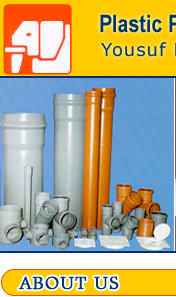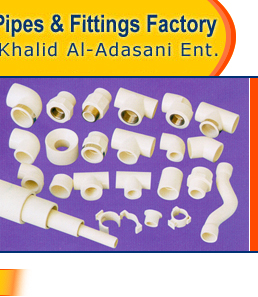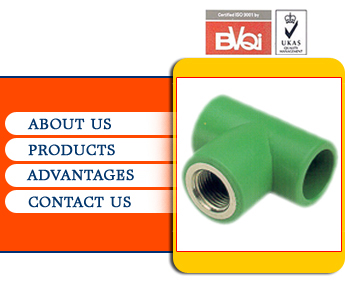 |
 |
 |
In 1974 Mr. Yousif Khalid Al-Adasani established the Plastic Pipes & Fittings Factory in Al-Rai area in Kuwait and since that time is the pioneer in U-PVC Pipes and fittings industry in the Gulf region.
Today the factory is located in Sabhan Industrial Area enjoys a high reputation for the supply of U-PVC, C-PVC and Polyethylene and Polyethylene pipes covering a production capacity of 15500 tones a year.
Our Factory
The factory is provided with a first class laboratory for quality control ensuring the compliance of its products with the international standards. Its products of U-PVC & C-PVC pipes and fittings are supplied in Kuwait and many other Gulf and Arab countries. ![]()
In November 1996 the factory achieved the International Quality System Certificate ISO 9002 crowning its efforts for continuous development and progress.
Major Advantages of using PVC & C- PVC Piping System.
Easy Installation
U-PVC and C - PVC pipes are light in weight (approximately one-half the weight of aluminum and one-sixth the weight of steel). They have smooth, seamless interior walls. No special tools are required for cutting. They can be installed using solvent cementing, threading, flanging and roll-grooved joining techniques. Chemical Resistance U-PVC and C-PVC pipes are insert to attack by strong acids, alkalis, salt solutions, alcohols, and many other chemicals. They are dependable in corrosive applications and impart no tastes or odors to materials carried in them. They do not react with the material carried in them. They do not react with materials carried, nor act as a catalyst. All possibilities of contamination, or chemical process changes, and all danger of clouding slugging, or discoloration are eliminated.
Strength
U-PVC and C-PVC pipes are highly resilient, tough and durable products that have high tensile and high impact strength. They will withstand surprisingly high pressure for long periods.
Fire Resistance
U-PVC and C-PVC products are self extinguish and will not support combustion.
Internal Corrosion Resistance
U-PVC and C-PVC pipes resist chemical attack by most acids, alkalis, salts, and organic media such as alcohols and aliphatic hydrocarbons, with certain limits of temperature and pressure. They provide the needed chemical resistance, while eliminating the disadvantages of special metals, lined piping, glasses, wood ceramics, or other special corrosion-resisting materials, which formerly had to be used.
External Corrosion Resistance
Industrial fumes, humidity, salt water, weather atmosphere, or underground conditions regardless of type of soil or moisture encountered, cannot harm rigid U-PVC and C-PVC plastic pipe. Scratches or surface abrasions do not provide points which corrosive elements can attack.
Immunity to Galvanic or Electrolytic Attack
U-PVC and C-PVC pipes are inherently immune to galvanic or electrolytic action. They can be used underground, underwater, in the presence of metals, and can be connected to other materials, or used as an insulator between them.
Freedom from Toxicity, Odors, Tastes
U-PVC and C-PVC piping systems are nontoxic, odorless, and tasteless. They have been listed by the National Sanitation Foundation (NSF) for use with potable water in U.S.A and worldwide.
Corrosion Free
With many other pipe materials, slight corrosion may occur. The corroded particles can contaminate the piped fluid complicating further processing, or causing bad taste, odors, or discoloration. This is particularly undesirable when the piped fluid is for domestic consumption. With U-PVC and C-PVC, there are no corrosive by-products, therefore, no contamination of the piped fluid.
Low Friction Loss
The Smooth interior surface of U-PVC and C-PVC pipe, compared to metal and other piping materials, assure low friction loss and high flow rate. Additionally, since U-PVC and C-PVC pipe will not rust, pit scale or corrode, the high flow rates will be maintained for the file of the piping system.
Low Thermal Conductivity
U-PVC and C-PVC pipes have a much lower thermal conductivity factor than metal pipe, therefore, fluids being piped maintain a more constant temperature. In most cases, pipe insulation is not required.
Low Installation Cost
U-PVC and C-PVC pipes are extremely light weight, convenient to handle, relatively flexible, and easy to installed costs than conventional metal piping.
Maintenance Free
Once a U-PVC or C-PVC piping system is properly selected, designed, and installed, it is virtually maintenance free. It will not rust, scale, pit, corrode, or promote build-up on the interior. Therefore, years o![]() f trouble-free service can be expected
f trouble-free service can be expected

